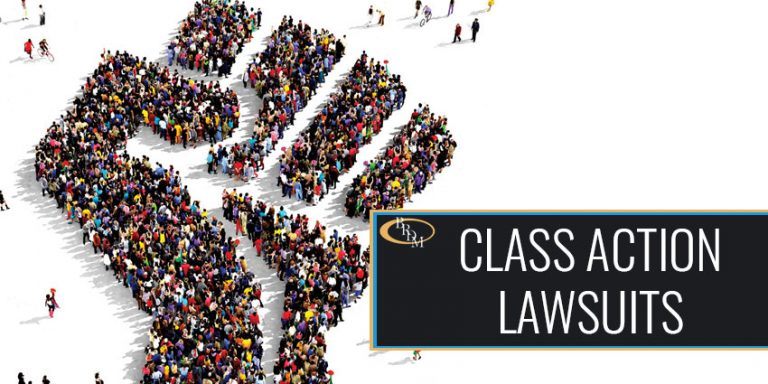Archer-Daniels-Midland Class Action Lawsuit: Your Legal Roadmap
Archer-Daniels-Midland Class Action Lawsuit: Your Legal Roadmap
Blog Article
Recognizing Class Action Suits: A Comprehensive Guide
Class activity suits have become increasingly usual in today's lawful landscape, forming the method people seek justice against powerful firms. In this detailed guide, we will check out the intricacies of class activity claims, including the kinds of cases that can be gone after, the steps entailed in filing a suit, and the advantages and drawbacks of seeking cumulative legal activity.
What Is a Course Activity Suit?
A course action suit is a legal case in which a team of people collectively brings a claim versus an offender or offenders for similar damage or misdeed. This sort of lawsuit enables a huge number of individuals that have actually suffered a comparable injury to join pressures and pursue lawsuit with each other, as opposed to submitting private legal actions. Course activity lawsuits are typically made use of in cases where the harm or wrongdoing impacts a big group of individuals, such as product responsibility cases, environmental air pollution cases, or instances entailing consumer scams.

In order for a lawsuit to be accredited as a course action, particular needs should be satisfied. These demands typically include numerosity (a lot of prospective class members), commonness (typical questions of legislation or reality), typicality (the insurance claims of the representative celebrations are normal of the class), and adequacy of representation (the agent events will rather and properly shield the interests of the class) Once a class activity claim is accredited, notification is supplied to possible course participants, that then have the option to join the legal action or opt-out if they want to pursue their own private insurance claims.
Types of Class Action Claims
There are various categories of class activity lawsuits that encompass a variety of lawful problems and industries. One typical kind is consumer course activities, which include claims made by a team of customers against a firm for false advertising and marketing, faulty products, or unreasonable company practices. These claims usually look for payment for the affected consumers and seek to hold the company liable for its actions.
Another category is safeties class actions, which are brought by investors versus a company for supposed securities scams. Future FinTech class action lawsuit. These lawsuits normally include cases of deceptive declarations or noninclusions in the business's economic declarations or disclosures, which triggered the capitalists to endure financial losses
Work class actions are likewise prevalent, including claims made by a team of employees versus their employer for offenses of labor legislations, such as discrimination, wage and hour violations, or wrongful termination. These lawsuits seek to safeguard the civil liberties of employees and make sure fair treatment in the work environment.

Steps Entailed in Filing a Course Action Lawsuit
Class action claims need a particular collection of actions to be adhered to in order to properly start the legal process. The initial step is to recognize the possible course members who have comparable insurance claims or complaints against the accused. This involves performing extensive study and event proof to sustain the claims. When the class members are determined, the next action is to appoint a lead plaintiff or course rep who will certainly act upon behalf of the entire class. The lead complainant will certainly work very closely with a skilled lawyer that specializes in course activity suits.
After the lead complainant is appointed, the following action is to file a complaint with the court. The problem details the claims versus the accused and the relief looked for by the course. It is necessary to make sure that the complaint meets all the lawful requirements and clearly mentions the claims of the course members.
When the grievance is filed, the court will assess it and identify if it satisfies the necessary criteria to proceed as a class action legal action. If the court approves the course qualification, notice will certainly be sent to all prospective class participants educating them concerning the claim and their civil liberties to participate or opt-out.
Following the class accreditation, the situation will continue through the exploration phase, where both celebrations exchange appropriate information and proof. This might involve depositions, interrogatories, and document demands.
Benefits and Drawbacks of Course Action Lawsuits
Among the vital advantages and disadvantages of going after a class activity legal action lies in its possible to give cumulative resolution for a group of people with comparable insurance claims against a defendant. The primary advantage of a class activity legal action is that it allows people with tiny cases to collaborate and take on an effective offender. By merging their sources and sharing the costs of litigation, course participants can access lawful depiction that they could not be able to afford independently. Furthermore, class actions can cause more efficient resolution of disputes, as they settle various cases right into a single claim, saving time and resources for both the complainants and the court system.
However, there are additionally drawbacks to course action claims. One significant concern is the possibility for insufficient depiction. Considering that the lead complainant represents the whole course, there is a danger that their passions may not line up with those of all class participants. Another disadvantage is the potential for low specific payments. Sometimes, the problems granted in a course activity lawsuit might be separated amongst a huge number of class participants, causing fairly small payment for every person. Lastly, course activities can be lengthy and intricate, frequently taking years to get to a resolution.
Current Landmark Course Activity Legal Action Instances
Recently, several significant course activity lawsuit instances have arised, establishing criteria and shaping the landscape of cumulative lawsuit. These landmark situations have actually highlighted various concerns and resulted in substantial negotiations, highlighting the power of class activity suits in seeking justice and holding firms liable.
One noteworthy instance is the Volkswagen "Dieselgate" rumor, where the automaker confessed to setting up software in their cars to cheat on exhausts tests. This instance resulted in a class action legal Assertio class action lawsuit action filed by afflicted consumers, resulting in a $14.7 billion negotiation. This site instance not only highlighted company deceptiveness but also brought interest to the ecological effect of such activities.
Thousands of legal actions were filed against the firm, alleging that their talc-based products created ovarian cancer cells and mesothelioma. These instances resulted in significant court decisions, with the highest possible being $4.7 billion.
Moreover, the opioid crisis has also caused many class action claims. Pharmaceutical distributors, business, and pharmacies have actually encountered lawful action for their declared duty in sustaining the epidemic. These cases intend to hold these entities liable for their activities and seek settlement for the areas affected by the dilemma.
These recent landmark cases show the relevance of course action claims in resolving corporate misbehavior and giving justice for afflicted individuals. They act as a tip of the power of collective lawsuit in holding effective entities answerable and seeking reasonable settlement for those hurt.
Conclusion
In conclusion, class activity lawsuits provide an opportunity for individuals to look for justice and compensation for extensive damage brought on by an offender. While they have their benefits, such as performance and cost-effectiveness, there are also disadvantages, such as prospective delays and minimal individual control (Archer-Daniels-Midland class action lawsuit). Current landmark cases have actually demonstrated the value of course action claims in resolving various issues, highlighting the significance of this legal system in making sure accessibility to justice for a lot of people
These needs commonly consist of numerosity (a big number of potential course participants), commonality (typical inquiries of legislation or truth), typicality (the cases of the representative celebrations are normal of the course), and competence of depiction (the agent parties will fairly and appropriately shield the passions of the class) Once a class action lawsuit is certified, notice is given to potential class participants, who after that have the option to sign up with the lawsuit or opt-out if they desire to seek their own individual cases.
Once the course participants are determined, the following action is to assign a lead complainant or course representative that will certainly act on part of the entire course. Since the lead plaintiff stands for the entire class, there is a threat that their interests may not line up with those of all class members. In some instances, the problems granted in a course action claim might be separated amongst a huge number of course members, resulting in fairly small compensation for each individual.
Report this page